Emirates Boeing 777 Business Class
Our New Year trip for 2020 ran from late January 2020 to mid-March 2020 and involved 8 nights in Dubai and 43 nights in Phuket.
We flew EK378 (Dubai-Phuket) and EK397 (Phuket-Dubai) on a Boeing 777 (this is not the Boeing 787 Dreamliner, but they share some design features).
For the Emirates Boeing 777 Business Class check out their video, and you can view your seating arrangements with their 3D 'immersive experience'. The only problem is that the videos you can find on YouTube, etc. don't present the actually seating options we had on our return trip Dubai-Phuket-Dubai. Most of the videos present a new seating option that was introduced in around 2017, and the remaining videos are of options that look just a bit different. Many of the variations look almost the same, but if you look carefully the detachable screen looks different and is positioned differently in the seating area. Frankly, I've not been able to find a video with the exact seating options we found on our trips.
Recently I found a really outstanding video presentation of a 2016 'new' seating configuration, which was identical to ours for the flight Phuket-Dubai (the only problem is that the review is in German). There are a lot of videos from 2017-2018 presenting a newer seating arrangement, possibly linked with a series of new deliveries of the 777-300ER.
Our Aeroplanes
Let's move now to our actual round trip Dubai-Phuket-Dubai on a Boeing 777. The only direct flights from Dubai to Thailand, are to Bangkok and Phuket. And Emirates are the only company to ensure a direct flight Dubai-Phuket (Thai provides direct flights Dubai-Bangkok).
A quick scan tells us that there were (at that time) 2 round trip flights a day between Dubai and Phuket, all with Emirates. From Dubai to Phuket there was EK378 departing at 11:30 and EK396 departing at 23:00. For Phuket to Dubai there was EK397 departing at 09:30, and EK379 departing at 01:35 (yes, in the night).
Emirates alway flies Boeing 777, model B77W, which is the code for the version Boeing 777-300ER. There are a number of versions of the 777. The first generation was the 777-200, 777-200ER (extended range) and the 777-300. The second generation includes the 777-200LR (long range), 777F (freight), and the 777-300ER.
It was in the 1960's and early 1970's that wide-body passenger jets were introduced with the Boeing 747, the McDonnell Douglas DC-10, and the Lockheed Tristar. In 1978 Boeing announced the wide-body 767 and was considering the 777 as a tri-jet. In the early 1980's ETOPS (Extended-Range Twin-Engine Operational Performance Standards) allowed the Boeing 767 to fly oceanic routes. In 1986 Boeing floated the idea to fill the gap between the 767 and the 747, initially with a 767-X. The market reaction was negative, so in 1988 Boeing decided to go for a new design, the Boeing 777.
The Boeing 777 family took its first flight in 1994 with the 777-200, which was introduced in 1995. It was Boeing's first fly-by-wire aircraft, and was the first commercial aircraft to be designed entirely with computer-aided design (CAD). The 777-300 was introduced in 1997 as a stretch version of the original Boeing 777-200. When we see the code 777-31H(ER) we knows that it is a 777-300ER for Emirates (customer code 1H). In fact Emirates operates the largest fleet of these aircraft (155 operating and 126 ordered). The ER means 'Extended Range', and the 777-300ER was designed to combine the added capacity of the 777-300 with the extended range of the older 777-200ER. According to Wikipedia the 777-300ER is viewed as a replacement of the Boeing 747-400, and it has roughly the same cost per seat/hour as the Airbus A380. Just looking at the order books the 777-200 and 777-300 only represent 148 orders from over 2,000, and it was the ER versions that made the 777 a fantastic success for Boeing (the success continues with new orders for the 777X).
Emirates operate two versions of the 777-300ER, one with 360 seats including 8 first-class suites, 42 flat-bed business seats and 310 economy seats. Our aircraft only had two classes, 42 business flat-bed seats and 386 economy seats for a total of 428 seats. I'm not sure of the exact range of the Emirates 777-300ER, but the 386 passenger version of the 777-300ER has a declared range of 14,594 kilometres according to Emirates.
The development of the 777-300ER implied a number of modifications to the older 777-200, due in part to the need to carry extra fuel (145,880 kilograms instead of 135,570 kilograms). The result was a change to the wingspan (64.80 metres compared to 60.92 mitres), to the engines (only the General Electric GE90-115BL1 engines are offered because they provide more thrust), and to the overall airframe structure. In addition the aerodynamics of the aircraft was altered with the addition of raked wingtips, thus reducing take-off field length, increasing climb performance, and reducing fuel burn. The operating empty weight increased from 159,570 kilograms to 167,829 kilograms (meaning the manufacturer's empty weight, plus standard items and operator items). The maximum structural payload weight increased from 64,960 kilograms to 69,853 kilograms (this is the difference between the maximum zero-fuel weight and the operational empty weight). There was considerable effort to look for ways to reduce the overall weight of the aircraft using composite materials.

The overall result was that the aircraft maximum take-off weight increased from 299,370 kilograms to 351,535 kilograms (the upper limit allowed for a take-off), and the maximum landing weight is 251,290 kilograms.
The list price of a 777-300ER is around $375 million (but discounts of up to 50% have been mentioned), and it takes 49 days to build.
Outgoing flight Dubai-Phuket
On the day our B777-300ER was scheduled to leave Dubai at 11:30 and arrive in Phuket 20:35 local time. Expected time of the flight was 5:55 hours, and the distance covered 4,932 kilometres. The aircraft was registered as A6-ENS (serial number 41365), making it 5.6 years old (delivered July 2014). A6-ENS was originally a 3-class aircraft, but the version without a crew rest area, i.e. not for very long haul flights. Below we have our exact aircraft at Schiphol.
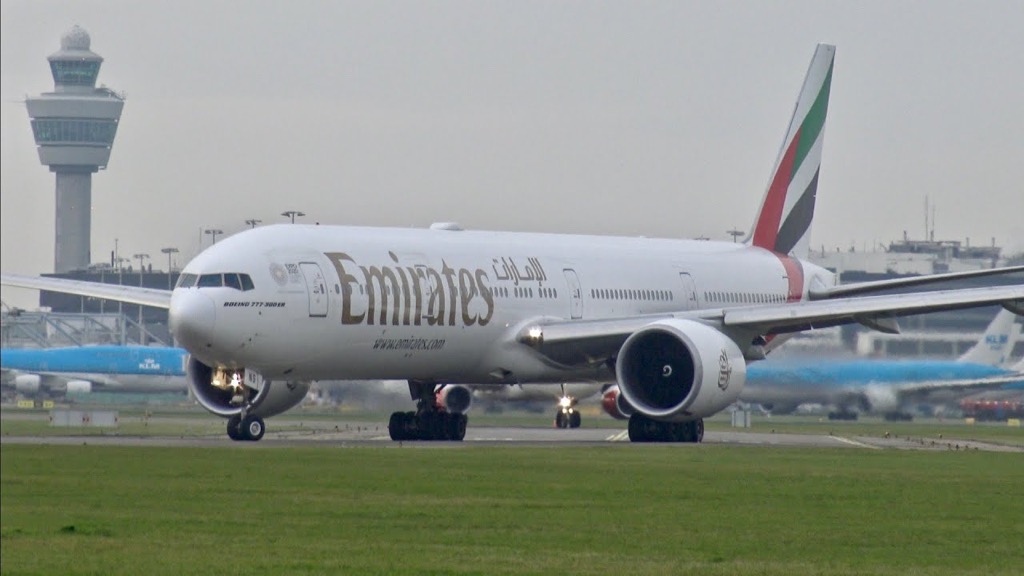
Our flight left from Gate A7 5 minutes late, and landed 16 minutes early, with a total flight time of only 5:44 hours. A6-ENS had come from Dammam and had arrive in Dubai on time at 06:45. In the day leading up to our flight, A6-ENS had made round trips to Karachi (23 Jan.), Larnaca/Luqu (22 Jan.) and Jakarta (21 Jan.).
In fact, originally we were planned to board from the lounge at Gate A16, but already when we entered the lounge this had changed to Gate A15. Quite quickly we were then informed that the gate would change again, and finally Gate 7 appeared on the screens. Gate 7 is not a boarding gate from the lounge. It's a service gate for the busses to take passengers out to a parked aircraft. On the trip I finally understood the size of the airport at Dubai. We would approach an area of parked aircraft, then turn away and find another set of parked aircraft, only to turn away again. Our aircraft appeared to be parked in the furthest part of the airport. According to all the flight data we left only 5 minutes late, which is amazing since we must have spent 10-15 minutes in the bus.
However, Dubai is not a mega-airport, and (as far as I know) it is smaller than both Frankfurt and Schiphol. In fact in September 2019 Beijing Daxing International Airport was physically the largest, but everyone expects it to be de-throned in the mid-2020's by Istanbul's new airport.
I'm told that the official total flight time is from when the parking brake is released at the departure gate, until it is again put on at the arrival gate.
In the past our particular aircraft A6-ENS has been spotted in few different places in addition to Dubai, for example, Amsterdam, Milan, Kuala Lumpur, Rome, Warsaw, Lisbon, and Perth.
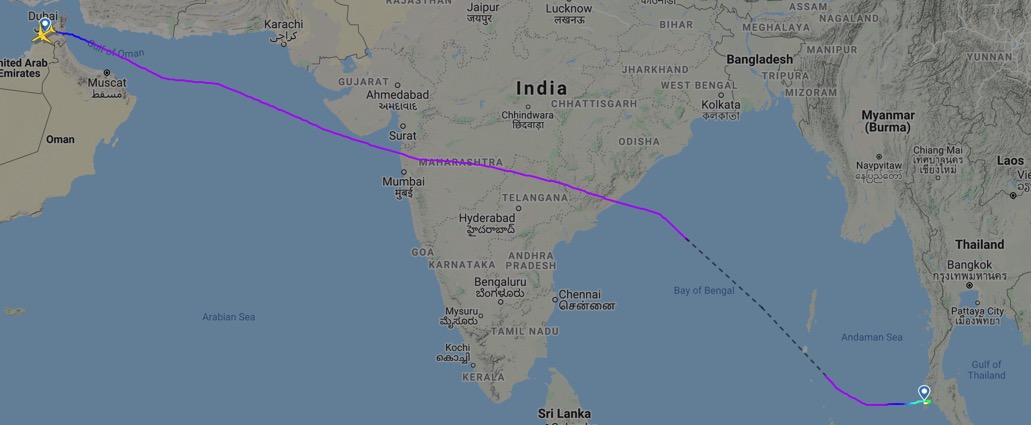
The route from Dubai to Phuket appeared to directly fly over the Gulf of Oman, avoiding to fly over Oman itself. It then crossed the Arabian Sea and passed just north of Mumbai. It then crossed India and the Bay of Bengal. I've seen different routes, but they all appear to avoid the Andaman Islands, passing North or South of them. The flight finished by crossing the Andaman Sea to Phuket.
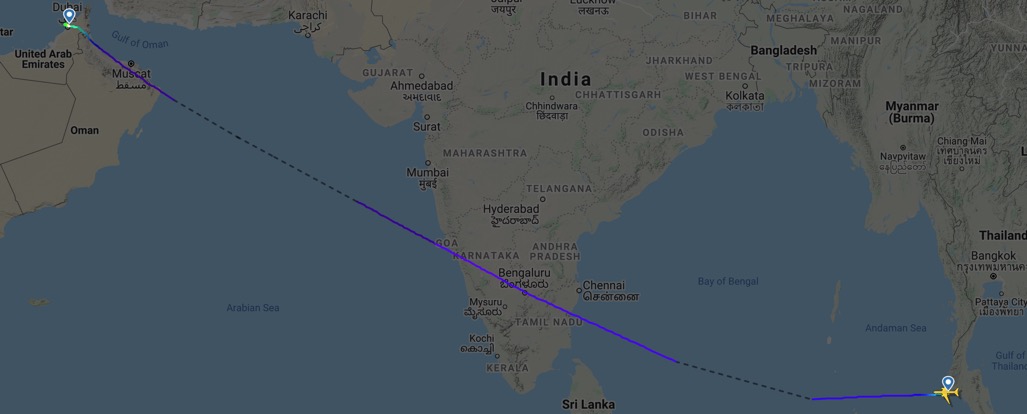
The return route Phuket-Dubai took a completely different route. Leaving Phuket the flight adopted a more southernly route, skirting the Nicobar Islands and crossing the southern part of India near Goa. The approach to Dubai was then over Oman, passing near Muscat.
The Andaman and Nicobar Islands are union territories of India.
Boarding
When we flew London-Dubai-Phuket we first flew on a A380, then on a Boeing 777. Flying back Phuket-Dubai-London we were first on a Boeing 777 and then on an A380. So how does the Boeing 777-300ER compare with the Airbus A380? A quick read through the online comparisons suggests that the 777 provides the worse passenger experience in every class of service, and on top of that Emirates runs a bait-and-switch by showing an A380 and then serving up a 777.
The boarding routine at Phuket was simple. Thanks to business-class check-in, fast-tracking through immigration and security we somehow found ourselves as one of the first to enter the 777, and as we entered we turned left towards the business class area. When the tourist class boarded they turned right, and frankly, we never saw them again. This is what we saw on entering the business class cabin.
I've provided a separate writeup on Phuket International Airport, and its business lounge.

What we see above is what is called a 2-3-2 configuration. Now many people think that the 2-3-2 configuration is unacceptable for a 'premium passenger experience'. This seating configuration, with a completely redesigned seat, was introduced in late 2016. It was said at the time that the seat was intended to look like a sports car seat. Now the primary purpose of a medium to long haul business class is to get some sleep, and a bit of luxury and service are a nice bonus. How many people want to sleep on a sports car seat? There are also many travellers who don't like the glossy faux burled walnut, or don't like it being overused as seen above. One review even called the cabin 'hideous'. Some people will admit that now the seat goes fully flat and there is a little more elbow room. And it's nice that your feet don't disappear into a footwell (as on the A380). However, the 72" pitch length means that it will come in under 6 feet long (183 cm), because the pitch includes the shell. In addition the seat is quite narrow, so a taller person can't sleep diagonally across the flat-bed. But many people see the middle seat as the 'deal breaker'. Sitting in the middle or in a window seat means straddling an aisle passenger in order to stretch their legs or visit the toilets. Other carries are installing direct aisle access in business class (like for example on the A380).
For many people the saving grace is Emirates inflight entertainment system, with a 23" high-definition monitor and it's 2,500 channels. On the flight Phuket-Dubai I watched 2 films, one an odd but well researched sci-fi, and the other in which an inordinate number of people were killed for no apparent reason. One report suggested that Emirates is planning a seating arrangement similar to the A380 in their next order of the 777X, which starts delivery in 2020. However I'm no so sure about this since Emirates own website shows what looks to be a 'conventional' 2-3-2 seating configuration.
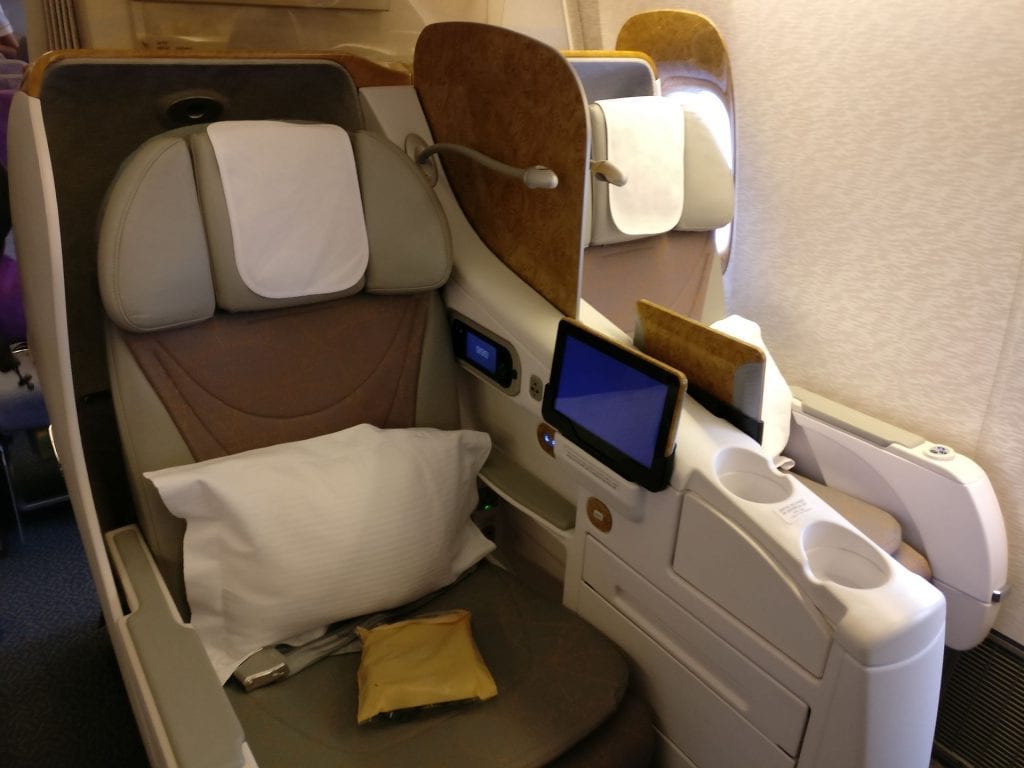
Our seat were 8A and 8B, so a window and aisle. It was very similar to what we see above, except that we had a window in each side panel. This is an important point when making seat reservation, because different seats have a different number of windows.
Initial impressions was that the business cabin is a spacious, well appointed and well organised space. There was plenty of space in the overhead locker for our gear, and as we sat down we were welcomed by the smiling Emirates cabin crew (smiling behind their face masks). Firstly a hot towel, then a tray of drinks including Champagne.
They also came around offering sleeping mattresses, a kind of thin foam mattress that covers the small gaps in the sections when you convert to a flat bed.
Sitting down we found a pillow, a blanket in a plastic bag, and the headphones (also in a plastic bag). There was a small bottle of water in the document pouch just under the 23" monitor. One of the problems I've always had, was what to do with the plastic bags, etc. This time they all went into the space between the seat and seat shell.
I managed to find a really outstanding video presentation of a 2016 'new' seating configuration, which was identical to ours for the flight Phuket-Dubai (the only problem is that the review is in German). It covers everything that was on our flight, including the 'mini' vanity set with just a pair of socks and eye mask.
The business cabin was about ½ full, but the hostess said that economy was 'nearly full'. Take-off went fine, although we left 21 minutes late (we landed in Dubai 1 minute late). According to the official record of the flight we left only 5 minutes late and landed 16 minutes early. The differences are probably due to different between leaving the parking spot and actual take-off, and landing and parking.
Breakfast was a bit slow in arriving, although the hostess was quite quick to come around to take our orders for both breakfast and lunch.

Breakfast was not much of a choice, i.e. continental, express, or nothing. Continental breakfast was fruit, yogurt, croissant with some butter and jam, orange juice and coffee/tea. We had already snacked in the business lounge in Phuket, so this breakfast was more than enough (my wife decided on the 'nothing' option).

For lunch we both took the Mediterranean seafood salad, Lemongrass chicken, and profiteroles. I enjoyed the starter, but my wife did not like the yellow peppers.

I did not bother photographing the main course, the Lemongrass chicken, because it neither looked like a Thai dish nor tasted like one.
However I enjoyed the profiteroles. Oddly enough they tasted like I remembered them many years ago in Italy, e.g. simple, small, filled with cream, glazed with chocolate, and just out of the fridge.

Strange, that no coffee/tea came round, just a little box containing two chocolates.
We can't really say it was a good meal, because it was let down by the main course. Although it was nice to see a proper place setting, with stainless steal cutlery, porcelain dishes, good glassware, and a nice cotton napkin. I'm still reminded of the tasteless gluten free meal my wife had on the outward legs. With the normal menu she was much happier, not happy-happy, but happier.
I do remember thinking that during take-off and landing there was a bit more vibration and noise than on the A380. I've read that it particularly pronounced at the back of the aircraft.
Frankly, with breakfast and then lunch, plus a decidedly less than memorable film, things went perfectly smoothly. I think that may be the biggest difference between the A380 and Boeing 777. We tend to retain a few positive comments about the A380, but can't think of much to say about the 777. So the 777 was like the film, un-memorable.
Return flight (Phuket-Dubai)
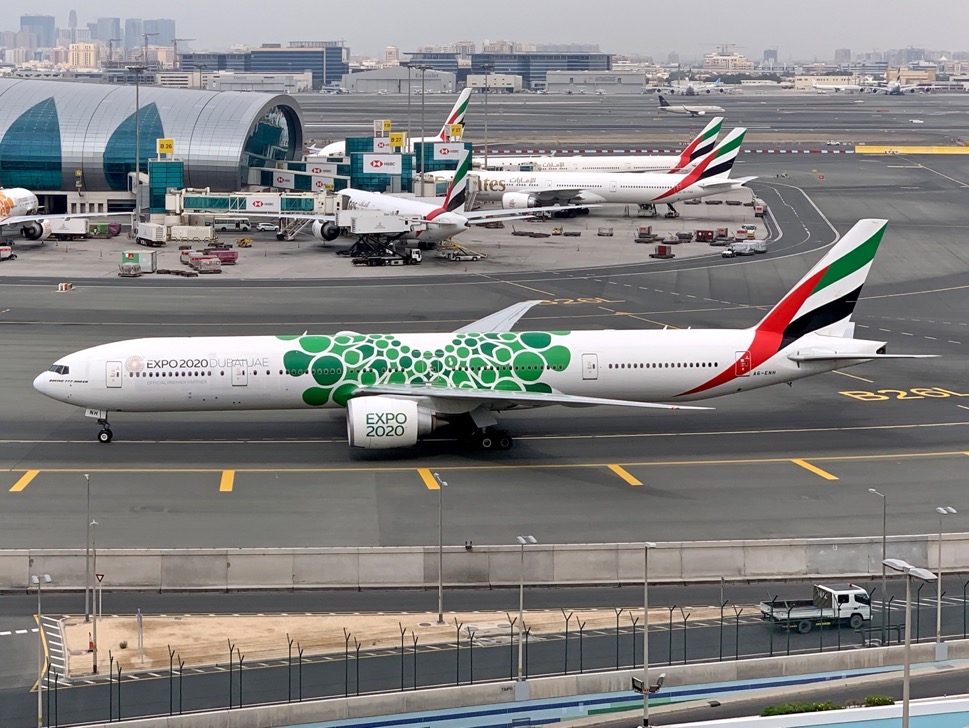
Our return flight EK397 Phuket-Dubai was on a Boeing 777-31H(ER) registration A6-ENH (serial no. 41086). Above we have a photograph of the exact aircraft in Dubai airport. There are a whole series of videos of this exact aircraft taking-off and landing are various airports, e.g. here is a video of the same aircraft taxiing and taking-off from Dubai. Unlike the aircraft used for Dubai-Phuket, this one was the 2-class version of the 777-300ER.
Our particular aircraft first flew on 7 February 2013, and was delivered to Emirates on 1 March 2013, so our 777 was 7 years old. It normally makes 78 flights monthly, and covers more than 335,000 kilometres/monthly (that's nearly 4,300 kilometres/flight). In the past our aircraft had been 'spotted' in Warsaw, Dusseldorf, Dhaka, Istanbul, Budapest, Hamburg, Munich, Milan, Copenhagen, Birmingham, as well as Dubai. Oddly it had never been 'spotted' in Thailand.
On the 6 March 2020 the aircraft had flown Dhaka-Dubai-Karachi-Dubai-Phuket before flying our Phuket-Dubai route on the 7 March 2020. Afterwards A6-ENH left for Lahore.
The scheduled departure time was 09:30 but we actually left the gate at 09:51 and took-off at 10:06. The flight time was 6:11 (from take-off) and we landed at 13:17 (two minutes late).
There is a video simulation of the flight EK397 Phuket-Dubai, but I'm not sure why anyone would want to watch it.
We had to get up quite early to catch our flight to Dubai. Our travel agent had organised the pick-up from the airport, and the return trip to the airport. At our resort hotel we received a message that a car would be waiting for us at 06:00, but by 06:20 no one was there. We phoned the contact number, and there was some confusion, but a car pulled up at about 06:30. The driver asked if we were waiting for a transfer to the airport. Naturally we said yes, and off we went. During the trip there was some confusion since we said that that we had been waiting since 06:00, but the driver said his instructions were for 06:45. However, he made it to the airport in record time. I'm convinced that we actually took the car of someone else, because at no time did we confirm any names, etc.
Emirates does not have a lounge at Phuket, but has an arrangement with the Coral Executive Lounge, which provides a kind of minimum service. Our assisted boarding went off without a hitch, and we took our seats in 2A and 2B. By this time the COVID-19 virus had started to take it's toll on international flight, and the business cabin was perhaps ¼ full. We settled in, ate breakfast (again), and slept until we were about to land.
We had assistance in Dubai airport that got us rapidly through immigration, luggage pickup, and customs. They dropped us off at the desk for the Emirates chauffeur cars, and they took us to our hotel.
Conclusion
The Boeing 777 is not an A380, but it does provide a decent business class service. The only comments I would have is that the 2-3-2 seat configuration in business class is unacceptable. The seats are a bit narrow which makes sleeping just that little bit more problematic. And I had the impression that the 777 was just a bit more noisy than the A380, particular taking-off and landing.